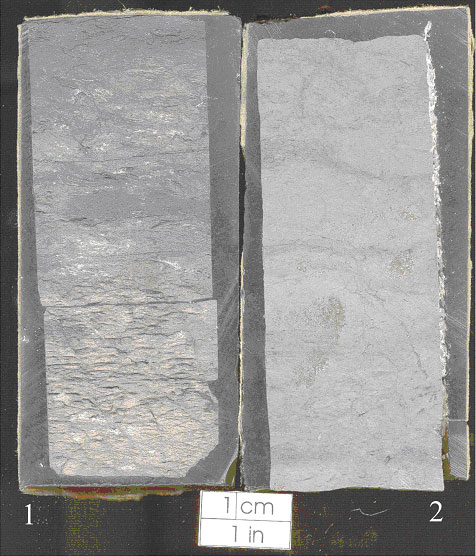 |
|
Kansas Geological Survey Open-file Report 2003-82 |
2.1.2 Blocky Mudstone Facies
Description
The blocky mudstone facies consists of micaceous shale that is light gray
to medium gray. Other features that characterize the blocky mudstone facies
include slickensides, blocky and mottled texture, and plant fragments (Figure
2.04). Clay ironstone nodules (siderite) are usually present in the lower
portion and decrease in abundance upwards. When the blocky mudstone facies
is associated with an underlying limestone, caliche nodules may be present
that are 0.25 inches in diameter (8 mm). Plant fragments and rhizoliths increase
in abundance upwards toward the top of the blocky mudstone facies. No trace
or body fossils were observed in the blocky mudstone facies. Thickness of
the blocky mudstone ranges from 0.25 to 10 feet (.1 to 3 m). The lower contact
is typically gradational with the underlying facies, while the upper contact
is sharp.
Paleoenvironmental Interpretation
Blocky or mottled texture with soil slickensides, and plant fragments are
evidence that the blocky mudstone lithofacies is a paleosol. Marine fossils
were not observed. Development of slickensides indicates frequent shrink-swell
cycles. These cycles are directly tied to paleoclimate. A higher frequency
of cycles is expected in a subhumid temperate climate (Gustavson, 1991). Factors
such as parent rock mineralogy, paleoclimate, duration of exposure, and rainfall
played a major roll in soil development (Gustavson, 1991). The facies was
probably formed in either an overbank area within an interfluve setting, or
in swampy conditions of a mire, with the sediment of the facies being derived
from pedogenic process acting on the underlying sediment, and wind derived
sediment. The gradational contact with the underlying facies is interpreted
as a C zone of a paleosol (Retallack, 1990). Historically, the blocky mudstone
facies would be interpreted as part of the “outside shale” in
the cyclothem model (Heckel, 1977).
 |
| Figure 2.04 - Polished core section showing blocky mudstone facies. Note pedogenic nature and weathered appearance of the mudstone. Soil slickensides are also observed within the blocky mudstone. Sample 1 from 780' and sample 2 from 870' in the Hinthorn CW#1 well, 14-T32S-R16E, Montgomery County, Kansas |
e-mail : webadmin@kgs.ku.edu
Last updated January 2004
http://www.kgs.ku.edu/PRS/publication/2003/ofr2003-82/chapter2_2.html